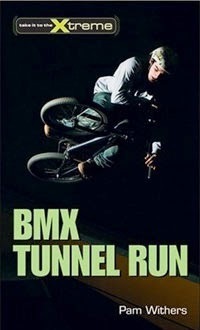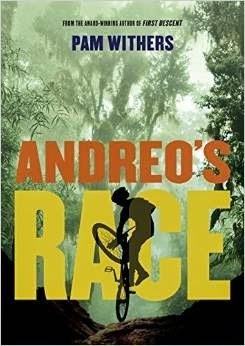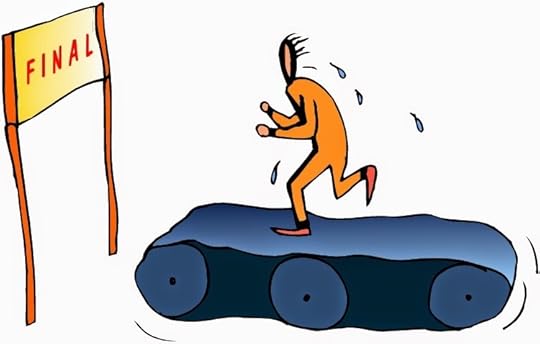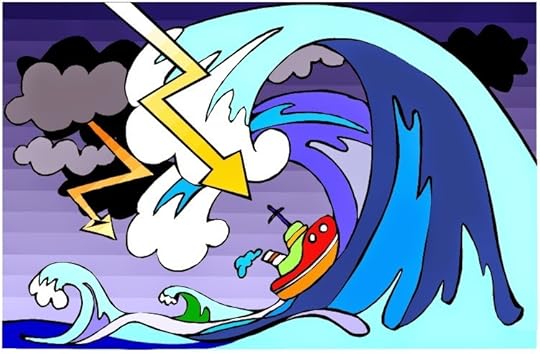Pam Withers's Blog, page 16
January 31, 2015
The story behind Mountainboard Maniacs

The tenth in a series of stories-behind-writing-the-books, which I offer intermittently here on my blog.
When best friends Jake and Peter discover mountainboarding, they decide it’s one of the best free-ride sports around. They’re stoked about bombing down slopes on what looks like a snowboard on spring-loaded wheels. When a junior guide training trip promises action on some of the Pacific Northwest’s largest mountains, they shrug off the fact that all three peaks are sleeping volcanoes that could erupt at any time. The boys find themselves in a complicated situation – there’s Peter’s secret agenda, Jake’s inner turmoil, the arrival of two girls and a nasty senior guide. But things really heat up when the mountain begins rumbling.
Find out whether Jake and Peter can get the group down the mountain alive in Mountainboard Maniacs, the explosive finish to Pam Withers’s Take it To the Xtreme series.
Mountainboard Maniacs: http://www.amazon.com/Mountainboard-Maniacs-Take-Xtreme-Withers/dp/1552859150/ref=sr_1_1?s=books&ie=UTF8&qid=1422732692&sr=1-1&keywords=mountainboard+maniacs
Three weeks before Mt. St. Helens erupted in 1980, friends and I foolishly ignored authorities and their road barriers in order to whitewater kayak the volcano’s Toutle River. The actual day of the eruption, we were caught in heavy ashfall 150 miles northeast, making it a struggle to see our way through final rapids on the Wenatchee River. I still recall pulling to shore, turning my boat over and soberly writing my name on it in the ash that fell as everyone thronged around car radios, shocked at the news. Mt. St. Helens, it turned out, had erupted much sooner and more violently than anyone had predicted. Had my Toutle and Wenatchee weekends been swapped around, it’s unlikely I’d be alive today.Clearly, it was my Mt. St. Helens experience that inspired Mountainboard Maniacs. But there were two things I needed to do before I could even begin outlining this novel:1. ask a volcano scientist how fast, on average, a mudflow would come down an erupting volcano (answer: 20 miles per hour)2. ask a mountainboarder how fast mountainboarders can board without killing themselves (answer: 60 miles per hour)With those two pieces of information, I knew my characters could outboard the killer flow, and my plotting took off from there. Naturally, I read a lot about the 1980 eruption before proceeding.Because I happened to visit Australia about this time, I sought out some Australian mountainboarders there, and they were very helpful in answering my questions as I shaped the novel. (How else could I have come up with lines like “I noticed you were putting too much pop in your pump, Peter,” or know the names of mountainboarding tricks like Chicken Salad Air?)One of the questions I asked my consultants, Peter ends up asking Australian guide Jarrad on p. 37: “Tell us some crazy things you’ve done on your board.”And Jarrad’s answer two pages later, of course, came from my real-life mountainboard helpers: “So we headed [into] this pipe on our boards. Figured it’d be an easy ride, that we’d get to work up some speed, maybe hit 30 miles per hour. Didn’t reckon on some idiot who didn’t know we were there opening the sluice gate and letting water out when we were about halfway down and still underground. We heard this rumbling behind us…”Obviously, that serves as a foreshadow of the mudflow that almost kills them on Mt. St. Helen’s.Although this book didn’t do particularly well in terms of sales (the sport is too strange or elite, I suppose), it remains one of my favorite. I worked very hard to make the plot, dialogue and character arcs work together as a grand finale to my ten-book series. One element I inserted was a theme about black and white: white chalk against a blackboard, the white moon against the black sky, the white snow on the volcano turning black when it erupted, the dark and light side of Melissa’s face and the lunar eclipse. It was meant to reflect the dark and light side of personalities (like Jarrad’s) and nature’s inevitable renewal of Mt. St. Helens after its eruptions (and Melissa’s renewal after her trauma).No one seemed to notice, not even my editor, so there you go! J But I dare readers to go through the novel now, looking for the black and white analagies.More trivia regarding the making of Mountainboard Maniacs:· I loved learning Australian expressions from a booklet for tourists that I picked up Down Under, and assigning them to Jarrad. (My favorite: “You’re moving like slugs in a drought.”)· My Australian mountainboard consultants gave me a video of mountainboard action, and one of its shots inspired the scene in Chapter Two where they leap into a river off a kickboard.· The triage exam with which the story opens is much like one I had to undergo to certify in advanced first aid.· Pretty much all the anecdotes that Peter trots out about the three volcanoes in the story, from the flash-fried elks to the JB Cooper story, are true anecdotes I picked up in my research.· Jake and I have the same birthday: July 31.
Many people have asked me how I felt about closing up the series, and turning to writing stand-alone adventure novels. My reply is a joking “ball and chain removed.” Writing a series is a fantastic opportunity to polish one’s writing skills under expert tutelage, establish one’s name in the market and plumb the depth and width of the series’ characters. But ten was stretching it, and by the end of the series, I was craving the opportunity to write without the parameters required for the Jake and Peter series. So, like any mother who must see her children leave the nest, I was okay with saying goodbye to Jake and Peter. They continue to live on thanks to readers out there, and I have thoroughly enjoyed re-reading the series recently in order to write these behind-the-scenes blogs. May they continue to entertain and inspire kids to read for many years!
Published on January 31, 2015 11:33
January 27, 2015
Why tackling boys’ issues helps girls too

“A rising tide lifts all boats.”— John F. Kennedy
This is the first generation of young men likely to achieve less education than their fathers and to find themselves on a lower rung of the socioeconomic ladder. Men now account for only four of every ten undergrads. The more educated a woman is, the more reluctant she is to “marry down” in terms of education and lifetime earning potential. Where there is a large educational gap between partners, divorce is more likely, and the struggles of children who go through divorce are well documented. College-educated people of both genders are more likely to get married and are much more likely to stay married. The decline in marriage rates has been greatest among men with less education. Those without a college education find it harder to stay employed in a rapidly changing work environment. Roughly three-quarters of the job losses inflicted by the 2008 U.S. recession fell on men. Marital conflict usually occurs when a man works less than his wife, or becomes unemployed. One in three married, working women today out-earns her husband—up from one in ten in the 1970s. Men who are economically dependent on their female partners are more likely to cheat on them. Women dependent on male partners are less likely to cheat. Two-thirds of all divorces are legally initiated by women. The poorer the household, the more likely parents are to send a girl rather than a boy on to college. This abrupt change from previous times reflects the parents’ desire to apply limited resources to the child who does best in school.
And finally, highlighting the ominous long-term effects of an imbalance: Children of unemployed fathers seem particularly vulnerable to psychological problems, are more likely to repeat a grade in school and to earn less as adults.
On a more positive note, “When boys’ test scores go up, so do girls’ scores,” says therapist and educator Michael Gurian in The Purpose of Boys. When adolescent boys find education to be purposeful and relevant, they are less defiant and more willing to learn, which frees girls up from having to deal with hours and days of behavioral problems around them.If there’s an underachieving boy in your life, rest assured that you are not alone, and there are ways to turn your son around.
Excerpted from Jump-Starting Boys: Help Your Reluctant Learner Find Success in School and Life, by Pam Withers and Cynthia Gill (Viva Editions). All references (footnotes) contained in the book. http://www.amazon.com/Jump-Starting-Boys-Reluctant-Learner-Success-ebook/dp/B00BAHA0Y8/ref=sr_1_1?s=books&ie=UTF8&qid=1422383849&sr=1-1&keywords=jump-starting
Published on January 27, 2015 10:40
January 24, 2015
Teens who write well get better paying jobs
[image error] If you're a teen, take note. If you have teens, let them know that studies show that teens with stronger writing skills are better at their jobs and get paid more! That's according to grammar checker website grammarly.com/grammar-check


Published on January 24, 2015 11:34
January 19, 2015
Seven reasons why boys are underachieving

1. Physical. Or, more accurately, denial that there’s a physical factor. In the age-old debate of nature versus nurture, it has become politically incorrect to acknowledge nature at all. In short, we’ve gone overboard in denying the physical differences between boys and girls and how this influences behavior, despite a growing body of studies replacing conjecture with facts.2. Reading/writing gap. In our commendable effort to right the historical wrongs of how girls have been treated and educated, we’ve blindsided ourselves to the one solitary respect in which boys are disadvantaged: reading and writing. And we’ve let that slip dangerously even as other trends (including the shift from industrial to service jobs) have aligned to make it of skyrocketing importance. The following cannot be emphasized enough: Boys are not the new underdogs; they are not suddenly suffering in all respects—only in reading and writing. But more than at any point in the past, reading and writing have become the linchpin of success in life.Boys, not to mention many parents, don’t know this. And some parents, teachers, and librarians have been loath to address that increasing gap on the false assumption that focusing on it will necessarily mean a backward slide for girls just as girls have secured some hard-won progress. Yet, on the contrary, a backward slide for boys has ominous potential for females who, in the end, must share their world with males.3. Home structure. An increasing number of boys are growing up in households with limited or no access to positive and involved male role models. While there are ways to minimize the potential negative impact of this, many parents are unaware of the implications and of some solutions, from reading buddies to mentors from programs like Big Brothers.4. School structure. The overwhelming majority of teachers and school librarians are female, and we’re also seeing an increase in female principals, education board members, legislators, and other education policymakers. Perhaps it is only natural, then, that classroom approaches, school policies, and sometimes the laws affecting education have shifted to formats that (often unwittingly) favor girls. Some eighty-five percent of children’s authors as well as most editors are also female, which means that the vast majority of people writing and editing and selecting books for school libraries are female. Parents are typically unaware of this, or feel they can do nothing about it. We believe awareness is important, and we outline what parents can do in Jump-Starting Boys. Of course, many of these biases are subtle and unintended. Female staff, like mothers in general, are well intentioned, but their hidden biases are no longer sufficiently countered by males at home and at school.5. Fear-based backlash. Because males are overrepresented among criminals and those who do females physical harm, individuals and sometimes organizations treat normal young boys’ tastes in reading and writing (war heroes, etc.) as unacceptable. This can be counterproductive to persuading them to read and write.6. Morals. Due to laws, education policies, societal changes, and multiculturalism, the onus for disciplining school-age children and giving them moral guidance has shifted from schools to the home. However, children spend more waking hours in school than at home, and parents are often unwilling or unable to provide the moral lessons that might help stem the bullying and violence that take place at school. This typically works against education, especially for boys.7. Parenting styles. For a generation or two, parents have been bombarded with the message that above all, they must build self-esteem in their children. Dutifully, they offer encouraging words as often as possible, repeatedly telling their beloved offspring that they can be something special. The result, say a growing number of experts, is children who grow up knowing deep down that many episodes of praise were unearned, which breeds insecurity rather than self-esteem. And the focus on self-esteem robs them of something more important for both work and personal life: empathy. So, more children feel entitled to special treatment, special jobs, a special life. Is it unreasonable that this sense of entitlement, combined with the factors outlined above, might feed into boys’ rejection of school if school is a struggle for them?Add to that, parents’ desire to keep their children safe, which can lead to overprotection and reduces kids’ opportunities to gain self-confidence and independence. Then there is the fact that some parents allow a child’s schedule to get so packed, structured, and parent-monitored that again, certain characteristics best nurtured by independent free time are stunted. Excerpted from Jump- Starting Boys: Help Your Reluctant Learner Find Success in School and Life, by Pam Withers and Cynthia Gill (Viva Editions). All references (footnotes) contained in the book. http://www.amazon.com/Jump-Starting-Boys-Reluctant-Learner-Success-ebook/dp/B00BAHA0Y8/ref=sr_1_1?s=books&ie=UTF8&qid=1421714857&sr=1-1&keywords=jump-starting+boys
Published on January 19, 2015 16:48
January 16, 2015
The story behind writing BMX Tunnel Run

The ninth in my stories-behind-writing-the-books, which I offer intermittently here on my blog.
In between racing and dirt-jumping their BMX bikes, daredevil fifteen-year-old best friends Jake and Peter discover an astonishing underground maze of old mining tunnels. Equipped with night-vision goggles, they get drawn into riding underground – defying a group of hostile riders and surviving unexpected tremors. As they attempt to race their bikes against time back up to daylight, Peter must come to terms with personal misfortunes threatening to suffocate all that he has come to think of as normal.
I was supposed to be outlining the ninth book in my Extreme series, on BMX biking, when I found myself reading Dean Koontz’s thriller Seize the Night – involving a bunch of guys running around old army tunnels wearing night-vision goggles. “My BMXers can do that!” I mused.So I had my characters stumble across a box of military night-vision goggles in a garbage dump, as well as an astounding maze of old mining tunnels.After reading a few books on mining, I made an appointment with mining manager Terry Johnson of Britannia, British Columbia. My fear was that when I told him my idea for my plot, he’d refuse to work with me. And indeed, he did cross his arms and glare at me a little. So I asked him, “Do you have any grandchildren?”“Six.”“You do realize that each and every one of your grandchildren will receive autographed copies of BMX Tunnel Run if you help me?”Well, after that he turned friendly. He gave me my own tour of the mine entrances, explained rockfalls and tunnel dynamics and also showed me an oxygen meter that miners wear on their belts: It beeps when the tunnels start running out of oxygen. I made sure that Peter, Jake and their friends got their hands on those to go with their night-vision goggles.Terry read all pertinent aspects of the manuscript; he was an enormous help. And all his six grandchildren got autographed copies of the book the following fall.Of course, how could I write about night-vision goggles without having some myself? So I ordered a pair from eBay, only to learn that it was illegal for them to cross the U.S./Canadian border. So while I did get to try them out and show them off at a few school talks, I could not do so on both sides of the border. I eventually donated them to a Boy Scouts club.As research on BMX biking, I hung out at a BMX race course with local English teacher Laura Knowles, who at the time also happened to be a two-time BMX provincial champion racer, BMX coach and mother of BMX racers Russell and Kasey Knowles. (Kasey was a three-time Canadian national champion -- and as readers can tell, I like naming some characters after people helping me with a book.) They helped me with all aspects of BMX plotting and wording. How else could I have written a paragraph like this?
“Micah has the holeshot coming out of the gate, but Braden goes low into the corner. Oh! Chase has been forced up on the berm. Russell pre-manuals the first bump in the rhythm section. Way to go! Kasey completes the whole third straight on her back wheel, Lucas jumps the triple, but Will manuals and squeezes past while Lucas is in the air.”
Other trivia regarding writing BMX Tunnel Run:For the opening scene of biking through a corn maze, I sought out and wandered through a corn maze (with my reluctant niece Alyson).The mining ghost-town was based on one that used to exist (but has since been torn down) near Britannia Mining Museum in British Columbia, Canada.By this ninth book in my series, I was struggling a little to introduce an angle I had not covered before. “Make Peter suffer setbacks,” my husband suggested. It’s true that Peter has always been the privileged one, with his wealthy and intact family. So I took Steve’s advice and had both Peter's parents lose their jobs, which in turn led them to pull Peter out of private school and put their cabin up for sale. That tension blended well with the weekenders-versus-townies tension in the community where the novel was set. There’s a scene where Russell is sitting inside an immobilized military tank. I had my nephew Jonathan, who had recently served in Iraq, help me with the description of the inside of a tank.I was pleasantly surprised to learn that the contortionist Houdini really did teach coal miners how to slow their breathing in case of a cave-in, which worked well with my plot.In retrospect, re-reading the novel all these years later, I’m amazed how much foolish behavior and danger I inserted into the plot. But in the novel's Acknowledgments, I emphasize with Terry’s help that: “It is extraordinarily dangerous to go into an abandoned mining tunnel. Trespassers in such tunnels frequently drop dead with no warning due to a lack of oxygen. ‘Pockets of oxygen deficiency’ are very real and very unpredictable. They can occur anywhere, anytime underground, including in spaces that had sufficient oxygen just moments before. Air blasts and rockfalls, although less common in hardrock than soft rock mines, are real. Tunnel plugs can be made of a number of materials, none of which implies that one tunnel is safer than another.”So, readers can be daring and foolish in a virtual way, while growing their passion for reading.I’m pretty proud of the fact that all mining disasters retold by the BMXers are real historic anecdotes. Who’d have thought that BMX enthusiasts could emerge from reading a sports novel with more knowledge of mining history and dangers than most in the general population?
Published on January 16, 2015 13:47
January 14, 2015
Junior Library Guild orders my newest novel
 Here's some nice new-year's news: the Junior Library Guild has ordered a hardcover edition of Andreo's Race. Yeah! Yes, my new young-adult adventure novel is off the press shortly. I'll be telling you more in a few weeks, but it's available now for pre-order on Amazon. (Click the title above)
Here's some nice new-year's news: the Junior Library Guild has ordered a hardcover edition of Andreo's Race. Yeah! Yes, my new young-adult adventure novel is off the press shortly. I'll be telling you more in a few weeks, but it's available now for pre-order on Amazon. (Click the title above)
Published on January 14, 2015 11:05
January 8, 2015
Finishing a novel: Are we there yet?

I finished a novel yesterday. Or did I? When do I declare it’s done? When I’ve completed the final chapter of the first draft? The final chapter of the last draft? (What the heck is a last draft, anyway?!) When I feel ready to send it to my agent? Bingo. I’ve decided on the latter, though I feel like celebrating at each juncture of the former.
Anyway, “finishing” a novel can be a long process. Since I’ve just completed the process, here’s some insight into what it involves for me.
First, I have to be relatively happy with it, and have completed the first draft of the final chapter. (By then, most of the other chapters have been reworked many times already.) So I’m relatively happy with the project, but am not yet ready to send it anywhere.
What remains at this point is to ensure that the final chapter(s) “tie up loose ends.”Now, is THAT ever an involved process!
First, I read through the entire manuscript marking it in the margins with the following codes: FS, MYS, TL, TH and CH. You’ll never guess them, so here goes: foreshadowing, a mysterythat needs revealing by the end, a timelineitem, a word in need of a thesaurus(as in, there’s probably a better word), and something I may want to change (as in, the backpack should be orange, not blue, or I don’t really want the main character to blurt something out that resolves a mystery in that particular chapter.)
Then I create a little table of where these things are located: for instance, there are some sentences that were meant to serve as foreshadowings on pages 3, 12, 36, etc. And there are mysteries I purposely introduced and must eventually resolve on pages... (Where they are resolved, I mark the page number on those, too.)
Mystery item in my latest novel: Why is character X suspiciously happy that character Y is going on the trip? As revealed in Chapter 19, because character Z (her boss) told character X to get him on the trip, and as resolved in Chapter 20, because they wanted to do such-and-such to him. (No spoiler here, sorry.)
I also need a blank piece of paper and perhaps a calculator to figure out whether, when someone says, “My doctor’s appointment is on Tuesday,” I don’t say two pages later (when it’s Saturday), that the doctor’s appointment was two days prior. Nor do I say it’s someone’s birthday in a month, and somewhere else a timeline element reveals it was actually in two months. It’s very easy to have timelines not add up, so anywhere at all there’s a time element, I mark TL in the margin, then go through and make sure they all jive with each other.
As for the thesaurus, putting a word in brackets (and/or a TH in the margin) allows me to keep writing, knowing I’ll go back to it later and explore other options. I find there are certain words I tend to overuse (like glance), and I’d rather figure out the synonyms and use a wider range of words for what I’m saying BEFORE my editor points out that I need to do so.
Now, what I completed yesterday is a draft ready for my canyoneering consultants (since the book is on canyoneering, the sport involving people rappelling down waterfalls and navigating canyon systems). After I incorporate their suggestions/corrections, it goes to my teen editor, who keeps a sharp eye on teen dialogue and other aspects. When I’ve incorporated his feedback, it goes to my agent, who sends it to my publisher, who hopefully says, “Love it!”
Stay tuned on that front!
P.S. Right before I finish a manuscript, all else in my life gets put on hold, and quite often my back goes out from too much work. I'm like a horse-to-the-barn; you can't slow me down. Hence, the lack of blogs recently! :)
Published on January 08, 2015 14:32
December 31, 2014
A writing teacher writes me! (inspiring boys to write)

When my sister Cynthia and I co-authored Jump-Starting Boys -- our book on helping boys ages 7-17 read, write and achieve -- we obviously hoped it would touch readers (parents, educators and mentors) positively. We especially hoped so given that the project, supposed to take eight months to complete, turned out to be a labor of love to write (two years to research and write).So imagine our delight today when we received the following letter from a teacher. Thanks, Mr. Miller, for taking the time to let us know how it has helped you and your students.P.S. Happy new year, everyone! Hi Pam,
I'm learning a lot from Jump Starting Boys. I'm an English teacher at a
Votech high school, and the boys you write about are my kids.
I just finished the chapter on writing when one of my reluctant writers
replied to a comment (in Google Docs) I made about a character's "slight
death." I questioned how any death is slight, and he replied that not all
deaths are by violent blunt force.
Now my first instinct is to argue back (the deaths were Candy's dog and
Curley's wife) but your lesson caused me to stop. Instead of shutting down
his thinking, I'm going to ask him to write me some examples of slight vs.
violent deaths (not in the essay but in the comments and no points are on
the table).
Thank you for such a useful and enlightening book. My co-teacher and I have
been incorporating young adult fiction into the curriculum, and we're
letting the classics collect dust in the book closet.
Your chapter on writing is helping us to round out our instruction. Thank
you again.
Chris Miller
Published on December 31, 2014 15:11
December 16, 2014
Twas the week before Christmas & a dark and storm night

Well, okay, it was the week before the week before Christmas. But honestly, it was a dark and stormy night. As in, hurricane force winds. I was holed up in my cabin on a small island trying to finish my novel. Rain and wind whipped around me, making me wonder when a tree would fall on the house. But I had only a few chapters left to write, and no people interruptions, so easy, right?First my back went.Okay, been there before. Just means I pull out my headphones and dictate through Dragon while lying in bed. But no, the windstorm puts the power out, and my computer memory is almost gone.Okay, no problem. With my remaining battery power, I’ll just print out my last chapter (by flashlight) and carry on by candlelight and pencil. And recharge the computer when the power comes on in the morning. But no, the computer memory dies just as I push “print.” Okay, go to bed, recharge the computer in the morning and carry on. Meantime, crawl under a mountain of quilts as the cabin goes chilly, flashlight under my pillow. (The cat crawled under the mountain of quilts with me.)But no. Upon waking, I learn that my power cord has died. Totally died. So I have no access to the novel in my computer. (Remember, I’m on a small island, must book a ferry and drive into the city to buy a new power cord.) Had I backed everything up on a stick, I could have used my stick to plug into the library’s computer, or a friend’s. But no, hadn’t done that.So, I carry on in pencil (in shorthand, for those of you old enough to know what that is, since it goes faster and saves on arm weariness), and now that I’m home with my new cord and a working laptop that is willing to reveal where I left off on this novel, I’m good to convert the scribbles to type and bring her on home: finish up those last few chapters. Right? Except it’s the holidays. Maybe I’ll finish it after the holidays?Happy holidays to everyone!
Published on December 16, 2014 10:52
December 4, 2014
Calling all young Canadian writers & poets
 Calling young Canadian writers and poets!
Calling young Canadian writers and poets!Announcing the Book Week 2015 WRITING CONTEST for Kids & Teens
Do you love to write? Young writers from across Canada are invited to submit their stories and/or poems to the *Book Week 2015 Writing Contest for Kids & Teens. Judging is done by noted writers from across Canada. Students from Grades 4 to 12 are eligible to enter and one winner fromeach grade will receive a $250 gift certificate to the bookstore of his or her choice!
Winning entries will be posted on the Book Week website – www.bookweek.ca http://www.bookweek.ca
CONTEST DETAILS
Entries must be postmarked by January 31, 2015. They do not have to be received by this date.
Entrants must be in Grades 4 to 12 at the time of the contest deadline.
Entries must be written in English and must not exceed 1,500 words.
All entries must be original content and are limited to two entries per person.
All entries must include a fully complete ENTRY FORM. The form
is available at www.bookweek.ca under “Book Week 2015.”
Please staple one entry form to each story/poem being submitted; do not use paper clips, binder clips, folders or duotangs.
Entries may be handwritten or typed. No faxed or emailed entries will be accepted.
Due to the large volume of entries, we cannot acknowledge receipt of entry.
Contest open to residents of Canada only.
For more information on the Writing Contest, contact sandra@bookcentre.ca.
Winners will be announced on May 6, 2015 during TD Canadian Children’s Book Week 2015.
Organized by: The Canadian Children’s Book Centre Supporting the reading, writing and
illustrating of Canadian books for young readers since 1976.
www.bookcentre.ca
Published on December 04, 2014 12:23



